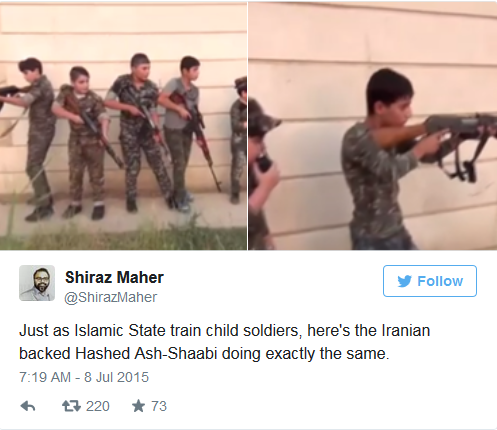The agony of Fallujah
Americans are intimately familiar with the city of Fallujah. It's where the Sunni resistance to the occupation of Iraq was born, and where nearly 100 American soldiers lost their lives in the bloodiest battle of the Iraq War. More than 1,500 civilians were killed and over 70,000 buildings were destroyed in those battles.
It's also where the Sunni rebellion in Iraq in 2014 began.
Today it has become the front lines in the war, and it just might be the worst the city has ever seen.
“The forces are considering the lives of civilians as thousands of innocents remain inside the towns,” said Brigadier General Yahia Rasoul of the corridor. “In the past we were concerned about the innocent people in these areas, but for the coming military campaign we need victory at any cost.”
The civilians of Fallujah are trapped in the battlefield. ISIS and other Sunni rebels have planted bombs and booby-traps at every entrance to the city to prevent the Shia militias from entering, but it has the secondary effect of preventing civilians from leaving.
"Since military operations began, it has become impossible to leave," said one 42-year-old teacher....
There are no precise figures for the remaining populations in either city. Hashemi said Falluja still had around half its pre-crisis population of 370,000.
Unlike the Battle of Tikrit in April, Fallujah is not an empty city.
There is something to keep in mind about this battle and it involves the belligerents.
The army of Baghdad is made up entirely of Shia militias.
While Fallujah's proximity to Baghdad, Iraq's capital, makes it strategically important for the Iraqi government, sending in militias that have been known to burn down Sunni villages might not pay off in the long run.
Eissa al-Issawi, the head of Fallujah’s local council, told the Post that if the Shia militias are allowed to lead the charge to retake the city from Islamic State (aka ISIS, ISIL, Daesh), "there would be much destruction, and much blood."
...Shia militias have emerged as the most effective fighting force against ISIS in Iraq, but some say the Shia fighters aren't much better than the ISIS terrorists they're trying to expunge.

The Baghdad government has very little control over the Shia militias. A Sunni tribal chief says the people fear the advancing Shia army because "their actions are not less in scale than those of ISIS". Fallujah has been under "continuous and indiscriminate bombardment" for two weeks now and no one realistically sees an end anytime soon.
In a turn of events, the United States is now doing what it said it would never do - openly assisting militias that are not under control of the Baghdad government.
In recent weeks Shia militias have engaged in deadly firefights with both Baghdad police and Kurdish peshmerga.


Comments
Same as it ever was.
"In 1920, an insurgency broke out in the area of Fallujah, where Sheikh Dhari killed a British officer, Colonel Leachman, and cut rail traffic between Fallujah and Baghdad. The British advanced towards Fallujah and inflicted "heavy punishment" on the tribe. The Royal Air Force, with Churchill's support, bombed rebellious villages and dissident tribesmen in Iraq. Churchill urged the employment of mustard gas, which had been used against Shia rebels in 1920."
"These assertions ignore the deeply-felt hostility to decades of colonial and semi-colonial rule by the Western powers, who long plundered Iraq’s oil reserves. During World War I, Mesopotamia was occupied by British forces, and it became a British mandated territory in 1920. In 1921, a kingdom was established under Faisal I, son of King Hussein of Hejaz and leader of the Arab Army in World War I. Britain withdrew from Iraq in 1932, but British and American oil companies retained their grip over the country."
Where did the number 1,500 civilian deaths come from?
The Lancet Medical Journal claims 98,000 civilians were killed in two major attacks on Fallujah, 2004. They got their information from Iraqi doctors and coroners. Time magazine downsized that number to 40,000 civilians.
Chemical weapons were used and there is documentation showing American troops shooting the wounded. As one Marine said, in the documentary "Hidden Massacre" - "we are doing the opposite of what we came here to do."
To thine own self be true.
Do you have a link?
I just used Wikipedia. I didn't bother to look into it further.
Sorry, I just read this now
I will get the links. Looks like the propagandists got to Wiki to give such a low number. The US ("coalition") wiped out 1/2 the population of Fallujah in the worst possible ways with chemical warfare. There're video's of the white phosphorus being dropped and there's a video of US military shooting the unarmed wounded. It's really painful to recall.
later...
To thine own self be true.
The death toll in Fallujah, 2004
Documentary: "The Hidden Massacre" shows the results of chemical weapons used in Fallujah by the US. You really don't want to see this. I just wanted to let you know it exists.
https://www.youtube.com/watch?v=yalyCk4kK-8
From MIT
From The Brussels Tribunal, 2013
The scandalous underestimation of Iraqi civilian casualties
Also Noam Chomsky wrote about this...
To thine own self be true.
Civilian deaths in Fallujah so far
Deaths from Baghdad bombardment since the ISIS takeover: 3,190 have been killed and 5,197 wounded
You were referring to the NEW death toll
I was thinking of the massacre that took place 10 years ago.
To thine own self be true.